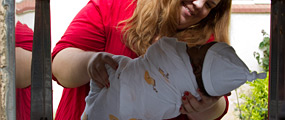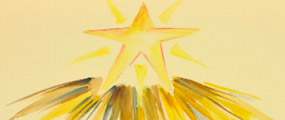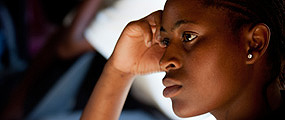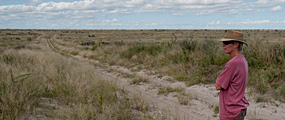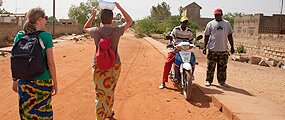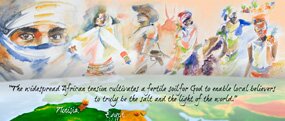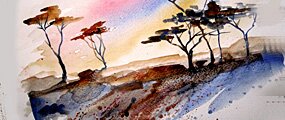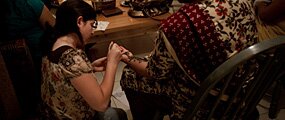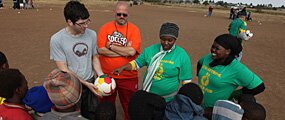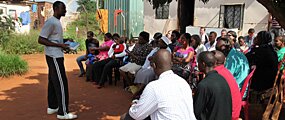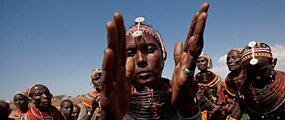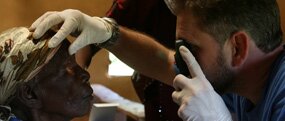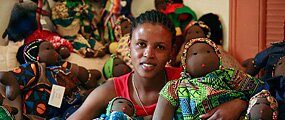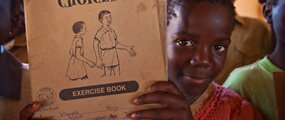Henna and the Gospel
Posted September 1, 2010
She squeezes the cone of greenish-gold paste and a small amount, guided by the movement of her fingers, forms the finishing touches of a fish drawing.
 Mina Rowland* focuses on the hand in front of her. She is drawing the Bible story about Jesus feeding 5,000 people with two fish and five loaves of bread. This storytelling session is one of hundreds of such gatherings Rowland has led throughout Africa and southern Asia.
Mina Rowland* focuses on the hand in front of her. She is drawing the Bible story about Jesus feeding 5,000 people with two fish and five loaves of bread. This storytelling session is one of hundreds of such gatherings Rowland has led throughout Africa and southern Asia.
Earlier in the evening Rowland, a Christian believer working in eastern Africa at the time, told the story to the 12 women gathered at her home. The women eagerly listened to the story and begged Rowland to draw the story on their hands using the paste called henna. Once dried, the paste creates a temporary tattoo that stays on the skin for several weeks.
Today believers in South Asia, the Middle East and Africa combine oral Bible storytelling and henna to share the Gospel. Henna is a significant part of these cultures, in which women draw beautiful designs on their hands and feet for special occasions.
Henna is a plant used to dye skin, hair, fingernails, leather or wool. It is commercially cultivated in several places including India, Pakistan, Bangladesh, Iran and Yemen. To be used as a dye, the leaves are ground and sifted to make a very fine powder, which is added to lemon juice or strong tea to make a paste. The paste is then used for application on the skin.
Ameena*, 18, lives in eastern Africa. She met with Rowland during the course of a few months to learn new stories and drawings. When Rowland first started sharing the stories of Jesus, Ameena was unsure in her faith.
Now, she says, “Jesus completes me and I want to start a henna group.” Once Ameena learns a new story, she’ll share with her neighbors as she draws the story on their hands.
Oral storytelling — the weaving together of the memories and lessons of life — is the main form of education throughout the world. In New Testament times, Jesus taught the people orally, using primarily stories and parables.
Many stories in the Bible contain visual symbols that can easily be incorporated into henna drawings. Henna storying allows many women around the world to learn about Jesus using an art form that’s been passed down for centuries.
 “Sometimes people care and want to hear the stories, sometimes they don’t,” Rowland says. “In the last year I’ve shared with more than 50 women in a group setting and 15 have either followed Christ or gone on to repeat the stories to others. People don’t mind listening to the story at least once.”
“Sometimes people care and want to hear the stories, sometimes they don’t,” Rowland says. “In the last year I’ve shared with more than 50 women in a group setting and 15 have either followed Christ or gone on to repeat the stories to others. People don’t mind listening to the story at least once.”
Rowland now serves in South Asia. Roenna*, a believer in that area, said after she had the story called Creation to Christ drawn on her hand she had several opportunities to share the Gospel. It’s a story weaving together the creation of the earth, prophecies and foreshadows of Christ, and Christ’s birth, death and resurrection.
Another lady in South Asia, Shanthi*, heard the Creation to Christ story. She got the drawing put on her hand and went to share with her daughters and their uncle. She wants to know more stories and learn more drawings to share with others. The uncle thanked Rowland for sharing the stories with his family.
In this ministry, Rowland takes advantage of the fact that women love to gather together enjoying conversation, laughter and friendship. While drawing the henna designs there is a chance for women to talk and build relationships. When women are wearing henna, others admire the art on their hands. In all these situations, there is an open door for the Gospel to be shared.
“It’s a bridge … into their culture to tell the stories through the art,” Rowland says. “I think it’s important that [you] look for bridges and ways in whatever culture you live in to share Christ. This is … done in a very cultural way, in a way that’s accepted, and in a way that’s very biblical.”
*name changed for security
Order the Henna and the Gospel booklet to learn how you can host a henna event in your home or church.

